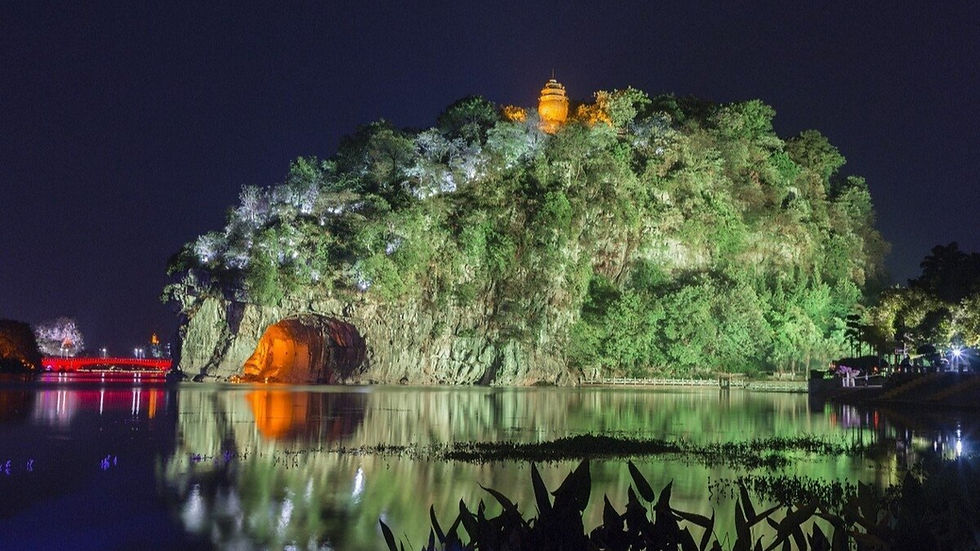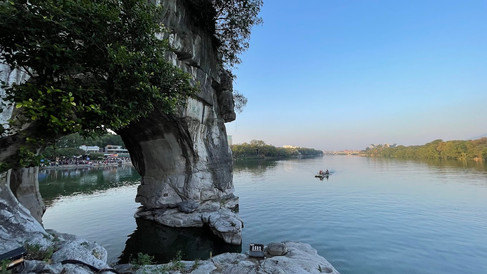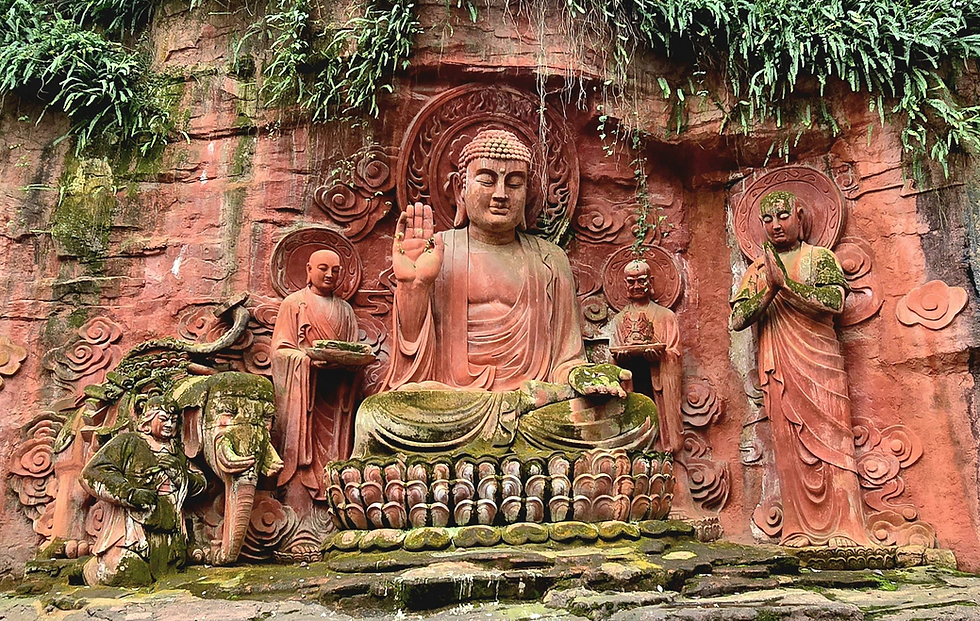Elephant Trunk Hill
- Shannon
- Oct 23
- 4 min read
Where the Mountain Drinks the River
At the meeting of the Li and Taohua Rivers, where mists drift like ancient spirits, rises Elephant Trunk Hill, Guilin’s most storied landmark and a masterpiece carved not by hands but by time itself. Formed from karst limestone more than 3.6 million years ago, the hill’s uncanny resemblance to a great elephant lowering its trunk into the water has long blurred the boundary between the natural and the divine. For over a thousand years, scholars, monks and travellers have stood on its banks, wondering if stone could indeed remember a celestial life.

The myth of its origin remains one of China’s most enduring folk legends. It is said that this elephant once served the Heavenly Emperor, carrying him valiantly across the skies in countless cosmic battles. When it was gravely wounded and abandoned on Earth, the people of Guilin tended to its wounds with herbs and song. Moved by their compassion, the elephant refused to return to heaven and instead lived among them, ploughing their fields and drawing water from the river. But compassion invited wrath. The Emperor, angered by its defiance, hurled a divine bolt that turned the creature to stone just as it bent to drink. The river swallowed its reflection and the sky sealed its fate.
The arch beneath its “trunk” known as the Water Moon Cave became a portal between worlds. When the moonlight strikes the river at a certain angle, the reflection beneath the arch aligns so perfectly that two moons appear. One floating on the surface, one suspended within the cave. To early monks and mystics, this phenomenon was more than beauty, it was enlightenment in motion. They believed the vision revealed the Buddhist concept of maya, illusion and truth intertwined, reminding all who gazed upon it that reality is but a reflection of the mind.
Over the last eleven centuries, Elephant Trunk Hill has been a living scroll of devotion and art. Its limestone face bears more than fifty ancient inscriptions, from Tang to Ming dynasties, each a testament to its spiritual and poetic magnetism. The most famous of these, carved during the Tang period, reads “Water Moon Cave,” a phrase that encapsulates both the scene and its Zen philosophy. Later poets, such as those of the Song dynasty, praised it as “the mirror of heaven and the heart of Guilin,” suggesting that the hill was not only a sight to behold but a state of being to enter.
Crowning the elephant’s back is the Puxian Pagoda, built during the Ming Dynasty in honour of Samantabhadra, the Bodhisattva of Great Practice, often symbolised by an elephant mount. The pagoda itself, slender and serene, once served as a beacon for river boats navigating the confluence, its light shimmering across the water like the flame of a guardian spirit. From afar, it appears as a saddle, an elegant symbol of divine restraint atop nature’s untamed form.
To the people of Guilin, the hill embodies more than legend or landscape, it is a guardian spirit. The elephant, in Chinese belief, represents wisdom, stability and prosperity. Its eternal presence at the junction of two life giving rivers was considered an omen of abundance.

Even during the dynastic wars that once swept through Guangxi, locals offered prayers at the base of the hill, believing that as long as the elephant stood, Guilin’s soul would endure.
Today, Elephant Trunk Hill remains both relic and revelation. It bridges science and story, limestone and legend, heaven and earth. To gaze upon its silhouette at dusk, with the moon rising through Water Moon Cave, is to glimpse a moment where myth becomes geography, where a fallen celestial being still drinks quietly from the river, forever between worlds, reminding all who visit that compassion, like stone, can outlast eternity.

🗺️ Location
No. 1 Binjiang Road, Xiangshan District, Guilin, China
🚆 How to get there
Elephant Trunk Hill is easily accessible from anywhere in central Guilin. It’s about a 10 minute walk from the Sun and Moon Pagodas and roughly fifteen minutes from Zhengyang Pedestrian Street, a popular dining and shopping area. Visitors staying in the city centre can take a short Didi ride or taxi, which usually costs very little due to the short distance. Several public bus routes also stop near the park entrance, including those running along Binjiang Road. Because of its location along the Li River, some river cruises also pass directly by the hill, offering a spectacular view of its “drinking elephant” profile from the water.
⭐ Attraction Info
The Elephant Trunk Hill Scenic Area is open year round, with seasonal hours that typically run between 7am - 6:30pm during the cooler months of November to March and between 6:30am - 7pm between April and October. Admission is usually around 55 - 70 yuan for adults, with discounted rates for children, students and seniors. Entry gives access not only to the hill itself but also to Water Moon Cave, Love Island and Puxian Pagoda at the summit. The park is most atmospheric in the early morning or late afternoon, when mist drifts across the river and the reflection of the “elephant” in the Li River appears almost lifelike.
象鼻山


















